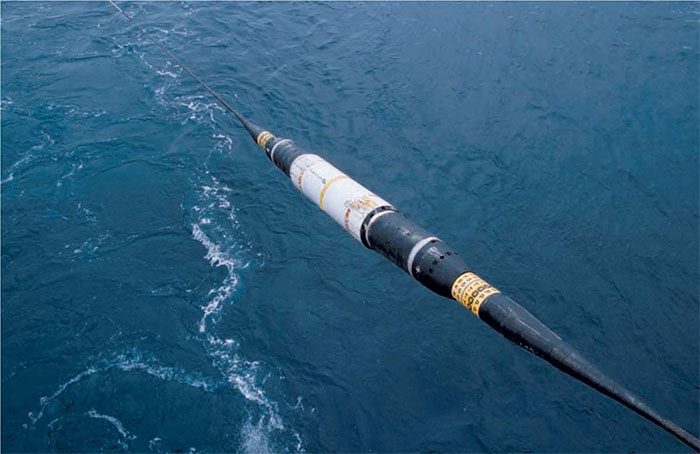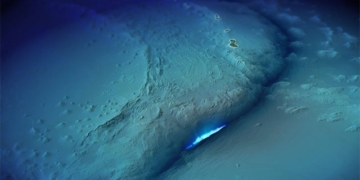A solar storm powerful enough could indeed lead to an “Internet Apocalypse,” a term referring to a sudden global disconnection of the Internet.
The term “Internet Apocalypse” has long been seen as a product of science fiction, where magnetic fields released by a super solar storm tear through the Earth’s atmosphere, sending currents through human infrastructure.
The auroras fill the southern sky unusually with shimmering blues and greens. Then, people look at their phones and suddenly, the Internet goes dark.
A Real Concern
“Internet Apocalypse” has been around for several years but is resurfacing more frequently on social media platforms like Reddit and Twitter, accompanied by fabricated information from NASA aimed at causing panic and drawing attention.

“Internet Apocalypse” refers to a rare event that could take down global Internet connectivity. (Image: GQ Magazine).
It is easy to understand why this hypothesis attracts attention. Modern life is closely tied to the Internet, and its absence could cause dire consequences. Many people can hardly endure 30 seconds in an elevator without Wi-Fi.
According to the Washington Post, this concern is not entirely fictional. Experts indicate that a widespread Internet disconnection could indeed happen.
The necessary condition to trigger an “Internet Apocalypse” is a powerful solar storm hitting the Earth — an event that, while rare, has occurred in the digital age.
Historically, only two such storms have been recorded in 1859 and 1921. The Carrington Event of 1859 burned out electrical systems in Europe and the United States, causing fires in several buildings and creating auroras at the equator near Colombia.
Additionally, in March 1989, a smaller storm caused a blackout across the entire province of Quebec, Canada, for 9 hours.

Sunspots on the surface of the Sun release solar storms, taking 8 minutes to reach Earth and potentially disrupting radio waves. (Image: NASA).
Typically, the Sun has a cycle of approximately 11 years to create a new cycle that causes the north and south poles to swap places.
The year 2014 marked the peak of solar activity intensity. During this time, plasma explosions occurred more frequently and violently.
When the magnetic fields change, they affect activities on the Sun’s surface, including the formation of sunspots, which are dark areas the size of planets.
Sunspots — dark areas on the Sun — help scientists track activities on its surface. These dark spots are the source of explosions and emissions of light, solar material, and energy into space.
During this time, solar flares, also known as solar storms, increase, sending electromagnetic radiation into space and even down to Earth. The peak of the current solar cycle is predicted to occur around mid-2025, according to CNN.
Sangeetha Abdu Jyothi, a computer science professor at the University of California who plays a role in popularizing this term, believes humanity has been complacent and has not prepared for this special event.

Image of a sunspot captured by the Daniel K. Inouye Telescope on January 28. (Image: National Science Foundation).
“We have never experienced the most severe incidents and have no idea how the Internet infrastructure will react. Our tests have not even included a scenario like a solar storm,” Jyothi stated.
Humans Are Not Prepared for Life Without the Internet
According to Jyothi, a sufficiently strong solar storm could impact large-scale infrastructures like undersea communication cables and could disrupt long-distance connectivity.
However, local and regional Internet connections would suffer less damage since fiber optic cables are not affected by geomagnetic induction currents.
On the other hand, the undersea fiber optic systems connecting the Internet between continents are a different story. The signal repeaters of these cables are very susceptible to geomagnetic currents, and the entire cable could become useless if a single repeater encounters issues.

Signal repeaters of undersea cables can be severely affected by solar storms. (Image: The Manomet Current).
In her research, Abdu Jyothi indicated that if a certain amount of undersea fiber optic cable in a specific area is affected, entire continents could be cut off from each other. Moreover, countries at higher latitudes like the United States and the United Kingdom are more susceptible to solar weather.
Therefore, if a massive geomagnetic storm occurs, countries at higher latitudes will be affected first. According to Abdu Jyothi, widespread Internet outages lasting weeks or months are possible due to the time-consuming nature of repairing underwater infrastructure.
“The economic impact of Internet disruption in a single day in the U.S. is estimated to exceed $7 billion; what would happen if the network system were to stop operating for several days or months?” Abdu Jyothi wrote in her research.
According to Internet activity tracking company NetBlocks, just in the U.S., the estimated losses would exceed $11 billion per day if an “Internet Apocalypse” were to occur.

Solar storms formed from explosions in the Sun’s atmosphere. (Image: NASA).
Weeks ago, scientists announced new evidence from the investigation into the origins of solar wind, which they say results from a phenomenon called “magnetic reconnection.”
Although the study did not specifically examine solar storms, it is broadly related. According to Stuart Bale, a physics professor at the University of California and also the principal investigator for NASA involved with the probe, the atmosphere of the Sun changes very slowly.
Thus, Bale believes it is challenging to form a storm strong enough to collapse the entire Internet network in the near future.


















































